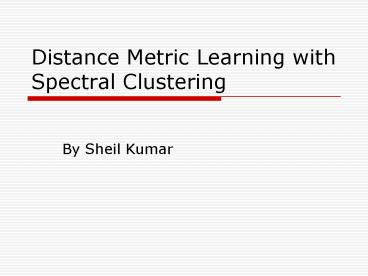Distance Metric Learning with Spectral Clustering - PowerPoint PPT Presentation
1 / 19
Title:
Distance Metric Learning with Spectral Clustering
Description:
Finding the sigma parameter automatically and optimally will give us better ... hard to formulate a RBF distance metric such that the sigma is easily isolatable. ... – PowerPoint PPT presentation
Number of Views:47
Avg rating:3.0/5.0
Title: Distance Metric Learning with Spectral Clustering
1
Distance Metric Learning with Spectral Clustering
- By Sheil Kumar
2
Spectral Clustering
- Based on the MinCut Problem
- Cuts deal with pairwise similarity measures, and
thus can capture non-linear relationships.
3
Spectral Clustering Cont.
sigma .1
4
Spectral Clustering Cont.
sigma .1
5
Spectral Clustering Cont.
- sigma 3
6
Motivation
- Finding the sigma parameter automatically and
optimally will give us better clustering of the
data. - It is hard to formulate a RBF distance metric
such that the sigma is easily isolatable. - Mahalanobis Distance?
7
Defining a Distance Metric
1) The distance metric must represent
similarities between data points. 2) Commonly
RBF Kernels are used as distance metrics in SC.
3) The Mahalanobis Distance must form positive
distance values representing similarity, NOT
dissimilarity.
8
The MinCut Problem
The about eqn is subject to constraints yi must
take on discrete binary values, and yTD1 0. If
y is relaxed to take on real values, this
minimization is equivalent to the eigenvalue
system
This eqn is easily shown by substituting z
D1/2y. z0 D1/21 is an eigenvector, with
eigenvalue 0.
9
Minimizing Eigenvectors
D-1/2(D-W)D-1/2 is a symmetric semi-positive
definite matrix because (D-W) (also known as the
Laplacian Matrix) is known to be symmetric
semi-positive definite. z0 is the smallest
eigenvector of D-1/2(D-W)D-1/2, and all other
eigenvectors are perpendicular to it. z1, the
second smallest eigenvector has the property
z1Tz0 0 y1TD1
10
Minimizing Eigenvectors Cont.
- Thus we obtain
- arg.min zTz0 0 zTD-1/2(D-W)D-1/2z
- zTz
- and equivalently
- arg.min yTD1 0 yT(D-W)y
- yTDy
- Minimizing the second smallest eigenvector
solution of this equation is guaranteed to give
us the normalized cut solution with the second
constraint satisfied.
11
Trace SDP
Given that the lambdas are eigenvector solutions
to matrix K, we see that minimizing over the
lambdas is equivalent to minimizing over the
tr(KB). Minimizing our second eigenvector can be
rewritten as a Procrustes Problem. B a weighted
outer product of the eigenvectors such that the
eigenvectors are normalized, and the weights are
in strictly increasing order.
12
Trace SDP Cont.
- Because we know that we want to only minimize our
second smallest and smallest eigenvector, we can
set alpha n and n-1 to 1, and the rest to 0.
13
Solving the SDP
14
The K Matrix
15
Solving the SDP Cont.
16
Solving the SDP
17
Some Results (more coming)
18
More results
19
Conclusions
- Unclear as of right now, whether linear
transformations help clustering. - More interesting Distance Metrics































